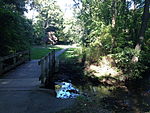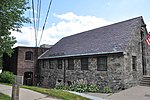Wellesley Farms station
Former Boston and Albany Railroad stationsMBTA Commuter Rail stations in Norfolk County, MassachusettsMassachusetts railway station stubsNational Register of Historic Places in Norfolk County, MassachusettsNorfolk County, Massachusetts Registered Historic Place stubs ... and 3 more
Railway stations in the United States opened in 1890Railway stations on the National Register of Historic Places in MassachusettsWellesley, Massachusetts

Wellesley Farms station is an MBTA Commuter Rail station in Wellesley, Massachusetts. It serves the Framingham/Worcester Line. It is located in the Wellesley Farms area. The current station building, designed by Henry Hobson Richardson in 1886 and constructed in 1890, has been listed on the U.S. National Register of Historic Places as Wellesley Farms Railroad Station since 1986.
Excerpt from the Wikipedia article Wellesley Farms station (License: CC BY-SA 3.0, Authors, Images).Wellesley Farms station
Croton Street,
Geographical coordinates (GPS) Address External links Nearby Places Show on map
Geographical coordinates (GPS)
| Latitude | Longitude |
|---|---|
| N 42.323194444444 ° | E -71.271944444444 ° |
Address
Croton Street 90
02462 , Wellesley Hills
Massachusetts, United States
Open on Google Maps











